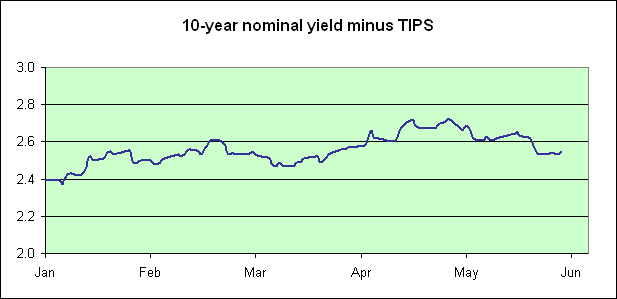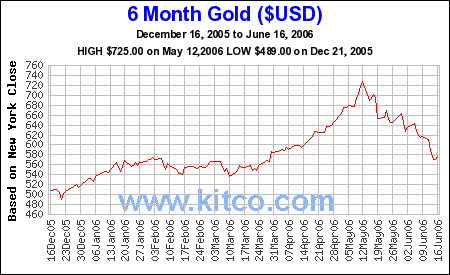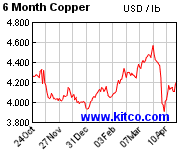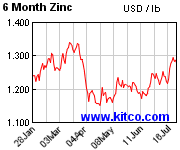Certainly the recent inflation data have been– Dave Altig says
insert something negative here, so I’ll just say “unwelcome”. But when Fed Chair Ben Bernanke declared that’s exactly the way he sees it, too, markets stood up and took notice. Let’s review some of the dramatic market adjustments that have occurred since Bernanke’s June 5 remarks.
For starters, we should all be clear that the Fed has no power to control the month-to-month gyrations in inflation measures on which the financial press likes to focus. Furthermore, anything the Fed does now likely will not have much effect on inflation until a few years down the road. In my mind, the key question is therefore, what has been the effect of recent data and Fed statements on markets’ perceptions of the Fed’s ability and commitment to keep inflation contained over the next decade? Here I agree with long, long time Fed watcher and inflation hawk Allan Meltzer that: “the best measure of Mr. Bernanke’s credibility is the bond market, and there is no sign there that traders expect big inflation or even much inflation.”

The above graph plots the difference in yield between nominal 10-year Treasuries and 10-year Treasury Inflation-Protected Securities, whose coupon and redemption value are both indexed to increase with the consumer price index. This difference might be interpreted as the average inflation rate that markets are anticipating over the next 10 years, as it will be measured by the “headline CPI”. This spread did edge up slightly this spring. But note the scale– this measure moved all the way from 2.5% in March to 2.7% in May. Even at its worst, markets had a lot of faith that the Fed was not about to let recent inflation rates continue. Moreover, that 20-basis-point bump in May has by now been entirely erased.

It’s also worth commenting on the phenomenal collapse in gold prices. The above graph from Kitco shows that all of the run-up in gold prices since March has unraveled since Bernanke’s remarks. Although I do not share the view of many that gold prices are a signal of investors’ inflation expectations, I do take the gold price dive as confirmation that the market believes that the Fed will slow output growth and raise real interest rates as far as needed to keep inflation contained, since both slower real output growth and higher real interest rates should reduce the relative price of sensitive commodities. The gold collapse might also be interpreted as exonerating in part Jeff Frankel’s view that real interest rates are the big drivers of commodity prices. Copper and zinc have also plunged over the last month.


And let’s not forget the whackage (that colorful term introduced by Barry Ritholtz) in equity markets. Once again I dispute the popular interpretation that inflation itself is the cause of the market’s decline. In a pure inflation, prices, wages, profits, and everything else one buys with dollars are all going up, and nominal equity prices should rise, not fall. There is, to be sure, a strong empirical suggestion that historical inflationary episodes have been harmful to real stock prices, which some analysts have attributed to the possibility that investors may discount future earnings with nominal rather than real yields (e.g., Ritter and Warr, Journal of Financial and Quantitative Analysis, 2002) or to the interaction between the tax code and inflation (e.g., Feldstein, American Economic Review, 1980). However, any such accounts would operate through an effect of inflation on increasing nominal interest rates, and the 10-year Treasury rate is right where it was before any of the recent whackage began.
 |
Paul Krugman and Robert Reich also have trouble seeing a resurgence of a wage-price spiral without the “wage” part, though see also Greg Mankiw’s discussion. But even without getting into the compensation issue, the most natural interpretation to me is the one that fits all the data– TIPS yields, nominal yields, commodity prices, stocks, and wages– with the same basic story. Investors responded to the unwelcome inflation numbers and recent Fed statements not because they believe that a resurgence of long-run inflation is now imminent, but instead because they knew that this meant the Fed is basically forced to raise real interest rates further, necessarily causing the incipient slowdown in economic growth to become even more dramatic and worrisome.
Steve Liesman writing at The Big Picture provides an analogy to the biblical account of Abraham, who had to prove his commitment to God by his willingness to sacrifice his son Isaac. Liesman argues that similarly, markets required Fed Chair Bernanke to establish his credentials by being willing to bring the U.S. economy to the brink of recession, if need be, to stop inflation.
Of course, it’s worth remembering how that particular story ended up. Isaac, seeing the preparations for a sacrifice, was understandably curious:
“The fire and wood are here,” Isaac said, “but where is the lamb for the burnt offering?”
Abraham answered, “God himself will provide the lamb…”
It remains to be seen what God may have in mind for getting us out of our current predicament.
Technorati Tags: Federal Reserve,
Bernanke,
macroeconomics,
inflation
I cannot believe that you support Liesman’s argument. If that is the price of changing the Fed chairman, then the Fed should be closed.
About AM’s measure: it’s not an indicator of Bernanke’s credibility, at best it is a measure of people’s expected inflation and a low expected inflation means, among other things, that people believe that the Fed will not go back to pre-October 1979 policies. It doesn’t mean anything about the Fed’s ability to fine tune price stability.
Where is the inflation? Over the last year there has been a 23.5% increase in energy costs. Through this month energy has risen 2.4%.
The food index increased 0.1 percent in May. The index for all items less food and energy rose 0.3 percent in May, the same as in each of the preceding two months.
Questions:
I am more than a little worried when William Poole, President of the Federal Reserve Bank of St. Louis, dismisses the BLS report by saying: “We may face more inflation pressure than currently shows up in formal data”.
My advice to President Poole and the rest of the Fed is to find a metric that DOES reflect inflationary pressure.
I’m not supporting Liesman’s argument, Edgardo. And my post begins with a specific statement that the Fed lacks the power to fine-tune inflation.
They already have it. They just need to measure it using the old formulas that don’t always “look better.” You know inflation because as a consumer you see it. If you don’t notice that, a FED report won’t help you much.
I’m sure you considered it and decided it wasn’t worth the extra verbiage, but I feel I have to bring up the possibility of an inflation risk premium in the nominal bond yield (compared to the TIPS yield). It doesn’t affect the story about changes in inflation expectations, but it has interesting implications about the absolute level of expected inflation. It seems to me that investors should be willing to pay a sizable premium for insurance against unexpected inflation, and this premium should equal the difference between the yield difference portrayed in the first chart above and the rate of inflation that investors actually expect. I would conservatively guesstimate the risk premium at 0.3%, which would imply actual inflation expectations around 2.2%. I have to keep reminding myself of how low that number is.
knzn — Thanks for that point about non-TIPS bond investors requiring an inflation risk premium that TIPS investors would not. I’d only add that TIPS investors face an additional risk, the prospect that previous additions to principal to compensate for inflation will be re-deducted in the event of deflation. I don’t know how to quantify either of these risks — your guestimate on the inflation risk premium seems as good as any — but I do think that subtracting TIPS yields from normal yields to get an expected inflation rate is too simplistic.
knzn – As Steve W notes, your point about the inflation risk premium is good. However, you probably need to offset it to some extent by the real rate (term) premium. The inflation-indexed bond tends to have a longer duration than the nominal Treasury because of the increasing value of the coupons over time. So, the real rate risk premium on the TIPS should be higher than the comparable risk premium on the nominal bond, no? Again, it’s probably not as large as the inflation risk premium, but it will mitigate that 30 bps to some extent and raise the 220 bps of expected inflation back towards the 2.5%.
Steve, I don’t think I would see the deflation possibility as a risk for TIPS investors. The reduction in principal should be fully compensated by a decline in the cost of living. There is the general risk that the CPI doesn’t measure the appropriate cost of living for a given investor, but it seems to me this risk must be much smaller than the risk assumed by a nominal bond investor, whose “cost of living allowance” is essentially set in advance. TIPS investors do face a possible liquidity risk because the market is thinner, but it’s hard for me to believe that is still important. You might argue that nominal bonds are a hedge against the economic stagnation likely to accompany deflation. (That argument shaves a few basis points off my risk premium guesstimate, which would otherwise be more than 0.3%.)
Kevin, Good point. If you think of it in real terms, a nominal bond is paying back some of your principal early to compensate for the fact that the real value of the ultimate principal payment will be smaller. It should be possible to deal with this effect analytically by looking at synthetic zero-coupon bonds. With today’s flat yield curve, though, it probably wouldn’t make much difference.
knzn — Good point. But still. I’ll just say, as a TIPS investor myself, I do worry about the possibility of loss of principal due to CPI deflation. I see CPI measures as problematic, and only very loosely related to my investment goals and personal needs. Within the universe of US “risk-free” fixed income, my own mix of TIPS vs nominal bonds is related to expectations as to the likelihood of future inflation vs price stability or future deflation, and I’m definitely hoping not to get it wrong. I don’t see TIPS as just a hedge that immunizes cost-of-living pseudoliabilities. I’m making a bet. As a general proposition, I don’t know if TIPS investors are mostly like me, or mostly people who see TIPS as an efficient hedge against changes in the price level. Perhaps you are right with respect to the market, and any deflation risk spread would be very small. Perhaps not, and the market would want a premium to cover this risk. Do you know of an empirical way to tell? Liquidity and maturity differences are also worth thinking about. Again, I think the lesson is that one must be very careful in inferring inflation expectations from TIPS/nominal spreads.
Just a dumb question, but does anyone have any ideas as to how much we should infer about domestic inflation expectations from nominal 10 yr bonds when the main (almost exclusive) buyer of those bonds is a central bank half a world away with a very different set of priorities?
2slugbaits, I would say that what matters is the marginal investor, not the average investor. And if there is a profit opportunity left on the table, the marginal investor is attracted in. If you think inflation will be way over 2.5%, you should short nominals and go long on the TIPS.
My intuition follows JDH’s, though I add that recent market movements carry for me the hint that the inflation the Fed targets could reveal a worrying intractability. This possible intractability peeks its head through JDH’s little phrase “to stop inflation.” Many questions come to mind regarding this question. Here’s one. Assume the Fed slows the economy, will “inflation” (energy prices) not again begin rising, assuming the Fed’s action had prior “stopped” such, as China and India and other countries march on developing?
There is a fundamental reason that I am skeptical of the “intractability” hypothesis. If energy prices were going to continue rising, it would be in the interest of speculators to buy and bid up the prices today, and those “future” energy price increases would already have happened. If this gradual increase in energy prices continues, the oil shorts will be like Charlie Brown on Thanksgiving. Year after year, Lucy takes away the football when he’s about to kick it, and he ends up falling on his back. I have to assume that energy traders are a bit more sophisticated than Charlie Brown, and if they haven’t already bid the prices higher, it’s because they have good reason to think that the price rises will come to an end.
Patrick,
Relying on one’s own impressions is a very tricky business when assessing the wider world. This is particularly true with regard to inflation. There is a pretty strong case that confirmation bias is at work when individuals assess consumer price trends. We notice changing prices to a much greater extent than we notice stable prices. We probably remember rising prices better than falling prices, because they bother us more. That’s why using an objective metric is a good idea – because it’s objective.
KNZN, year after year, spot oil prices have risen above numerous “psychological” and other thresholds, to ever higher levels. More importantly, with spot prices have risen futures prices, which tells you something about what futures traders actually know about the future: they don’t know, they have, at best, guesses, and I think those guesses are becoming more uncertain the higher energy prices rise. The intractability I suggest is this: energy prices and inflation are rising apace and are probably closely linked. Sure, the Fed can lower inflation by beating back demand, but in a tight energy market, with energy prices and inflation showing a close relationship, inflation is vanquished only so long as energy demand (and thus GDP growth) stay low. Looking to a larger context, I think China, in the medium term, would happily see US oil demand lessen. Their oil would be cheaper, their GDP growth higher, etc. Same for India etc.
By the way, and sorry for the double post, you’ll notice oil prices have not fallen with other commodity prices. What does that tell you about market uncertainty?